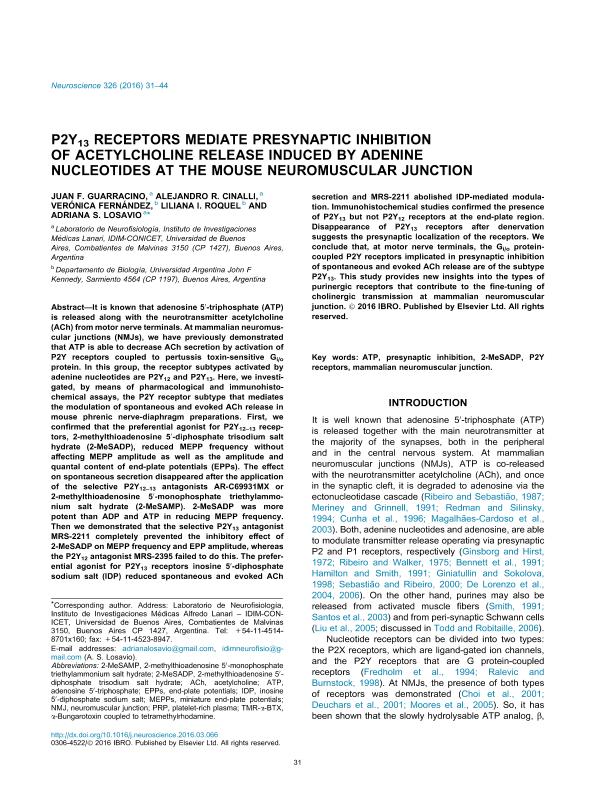Mostrar el registro sencillo del ítem
dc.contributor.author
Guarracino, Juan Francisco

dc.contributor.author
Cinalli, Alejandro Raúl

dc.contributor.author
Fernández, Verónica
dc.contributor.author
Roquel, LIliana
dc.contributor.author
Losavio, Adriana Silvia

dc.date.available
2018-04-16T15:57:16Z
dc.date.issued
2016-07-01
dc.identifier.citation
Guarracino, Juan Francisco; Cinalli, Alejandro Raúl; Fernández, Verónica; Roquel, LIliana; Losavio, Adriana Silvia; P2Y 13 receptors mediate presynaptic inhibition of acetylcholine release induced by adenine nucleotides at the mouse neuromuscular junction; Pergamon-Elsevier Science Ltd; Neuroscience; 326; 31-6-2016; 31-44
dc.identifier.issn
0306-4522
dc.identifier.uri
http://hdl.handle.net/11336/42123
dc.description.abstract
It is known that adenosine 5′-triphosphate (ATP) is released along with the neurotransmitter acetylcholine (ACh) from motor nerve terminals. At mammalian neuromuscular junctions (NMJs), we have previously demonstrated that ATP is able to decrease ACh secretion by activation of P2Y receptors coupled to pertussis toxin-sensitive Gi/o protein. In this group, the receptor subtypes activated by adenine nucleotides are P2Y12 and P2Y13. Here, we investigated, by means of pharmacological and immunohistochemical assays, the P2Y receptor subtype that mediates the modulation of spontaneous and evoked ACh release in mouse phrenic nerve-diaphragm preparations. First, we confirmed that the preferential agonist for P2Y12–13 receptors, 2-methylthioadenosine 5′-diphosphate trisodium salt hydrate (2-MeSADP), reduced MEPP frequency without affecting MEPP amplitude as well as the amplitude and quantal content of end-plate potentials (EPPs). The effect on spontaneous secretion disappeared after the application of the selective P2Y12–13 antagonists AR-C69931MX or 2-methylthioadenosine 5′-monophosphate triethylammonium salt hydrate (2-MeSAMP). 2-MeSADP was more potent than ADP and ATP in reducing MEPP frequency. Then we demonstrated that the selective P2Y13 antagonist MRS-2211 completely prevented the inhibitory effect of 2-MeSADP on MEPP frequency and EPP amplitude, whereas the P2Y12 antagonist MRS-2395 failed to do this. The preferential agonist for P2Y13 receptors inosine 5′-diphosphate sodium salt (IDP) reduced spontaneous and evoked ACh secretion and MRS-2211 abolished IDP-mediated modulation. Immunohistochemical studies confirmed the presence of P2Y13 but not P2Y12 receptors at the end-plate region. Disappearance of P2Y13 receptors after denervation suggests the presynaptic localization of the receptors. We conclude that, at motor nerve terminals, the Gi/o protein-coupled P2Y receptors implicated in presynaptic inhibition of spontaneous and evoked ACh release are of the subtype P2Y13. This study provides new insights into the types of purinergic receptors that contribute to the fine-tuning of cholinergic transmission at mammalian neuromuscular junction.
dc.format
application/pdf
dc.language.iso
eng
dc.publisher
Pergamon-Elsevier Science Ltd

dc.rights
info:eu-repo/semantics/openAccess
dc.rights.uri
https://creativecommons.org/licenses/by-nc-sa/2.5/ar/
dc.subject
Atp
dc.subject
Presynaptic Inhibition
dc.subject
2-Mesadp
dc.subject
P2y Receptors
dc.subject
Mammalian Neuromuscular Junction
dc.subject.classification
Otras Ciencias Biológicas

dc.subject.classification
Ciencias Biológicas

dc.subject.classification
CIENCIAS NATURALES Y EXACTAS

dc.title
P2Y 13 receptors mediate presynaptic inhibition of acetylcholine release induced by adenine nucleotides at the mouse neuromuscular junction
dc.type
info:eu-repo/semantics/article
dc.type
info:ar-repo/semantics/artículo
dc.type
info:eu-repo/semantics/publishedVersion
dc.date.updated
2018-04-13T14:33:46Z
dc.identifier.eissn
1873-7544
dc.journal.volume
326
dc.journal.pagination
31-44
dc.journal.pais
Estados Unidos

dc.journal.ciudad
Amsterdam
dc.description.fil
Fil: Guarracino, Juan Francisco. Consejo Nacional de Investigaciones Científicas y Técnicas. Oficina de Coordinación Administrativa Houssay. Instituto de Investigaciones Médicas. Universidad de Buenos Aires. Facultad de Medicina. Instituto de Investigaciones Médicas; Argentina
dc.description.fil
Fil: Cinalli, Alejandro Raúl. Consejo Nacional de Investigaciones Científicas y Técnicas. Oficina de Coordinación Administrativa Houssay. Instituto de Investigaciones Médicas. Universidad de Buenos Aires. Facultad de Medicina. Instituto de Investigaciones Médicas; Argentina
dc.description.fil
Fil: Fernández, Verónica. Universidad Argentina ; Argentina
dc.description.fil
Fil: Roquel, LIliana. Universidad Argentina ; Argentina
dc.description.fil
Fil: Losavio, Adriana Silvia. Consejo Nacional de Investigaciones Científicas y Técnicas. Oficina de Coordinación Administrativa Houssay. Instituto de Investigaciones Médicas. Universidad de Buenos Aires. Facultad de Medicina. Instituto de Investigaciones Médicas; Argentina
dc.journal.title
Neuroscience

dc.relation.alternativeid
info:eu-repo/semantics/altIdentifier/url/http://www.sciencedirect.com/science/article/pii/S0306452216300537
dc.relation.alternativeid
info:eu-repo/semantics/altIdentifier/doi/http://dx.doi.org/10.1016/j.neuroscience.2016.03.066
Archivos asociados
